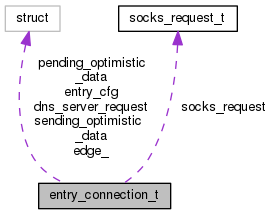#include <or.h>

Data Fields | |
| edge_connection_t | edge_ |
| char * | chosen_exit_name |
| socks_request_t * | socks_request |
| entry_port_cfg_t | entry_cfg |
| unsigned | nym_epoch |
| char * | original_dest_address |
| uint8_t | num_socks_retries |
| struct buf_t * | pending_optimistic_data |
| struct buf_t * | sending_optimistic_data |
| struct evdns_server_request * | dns_server_request |
| uint16_t | marked_pending_circ_line |
| const char * | marked_pending_circ_file |
| unsigned int | num_circuits_launched:4 |
| unsigned int | want_onehop:1 |
| unsigned int | use_begindir:1 |
| unsigned int | chosen_exit_optional:1 |
| unsigned int | chosen_exit_retries:3 |
| unsigned int | is_transparent_ap:1 |
| unsigned int | may_use_optimistic_data: 1 |
Detailed Description
Subtype of edge_connection_t for an "entry connection" – that is, a SOCKS connection, a DNS request, a TransPort connection or a NATD connection
Field Documentation
◆ chosen_exit_name
| char* chosen_exit_name |
Nickname of planned exit node – used with .exit support.
◆ chosen_exit_optional
| unsigned int chosen_exit_optional |
For AP connections only. If 1, and we fail to reach the chosen exit, stop requiring it.
◆ chosen_exit_retries
| unsigned int chosen_exit_retries |
For AP connections only. If non-zero, this exit node was picked as a result of the TrackHostExit, and the value decrements every time we fail to complete a circuit to our chosen exit – if it reaches zero, abandon the associated mapaddress.
◆ dns_server_request
| struct evdns_server_request* dns_server_request |
If this is a DNSPort connection, this field holds the pending DNS request that we're going to try to answer.
◆ is_transparent_ap
| unsigned int is_transparent_ap |
True iff this is an AP connection that came from a transparent or NATd connection
◆ may_use_optimistic_data
| unsigned int may_use_optimistic_data |
For AP connections only: Set if this connection's target exit node allows optimistic data (that is, data sent on this stream before the exit has sent a CONNECTED cell) and we have chosen to use it.
◆ num_circuits_launched
| unsigned int num_circuits_launched |
Number of times we've launched a circuit to handle this stream. If it gets too high, that could indicate an inconsistency between our "launch a circuit to handle this stream" logic and our "attach our stream to one of the available circuits" logic.
◆ num_socks_retries
| uint8_t num_socks_retries |
Number of times we've reassigned this application connection to a new circuit. We keep track because the timeout is longer if we've already retried several times.
◆ nym_epoch
| unsigned nym_epoch |
AP only: The newnym epoch in which we created this connection.
◆ original_dest_address
| char* original_dest_address |
AP only: The original requested address before we rewrote it.
◆ pending_optimistic_data
| struct buf_t* pending_optimistic_data |
For AP connections only: buffer for data that we have sent optimistically, which we might need to re-send if we have to retry this connection.
◆ socks_request
| socks_request_t* socks_request |
SOCKS structure describing request (AP only.)
◆ use_begindir
| unsigned int use_begindir |
True iff this stream should use a BEGIN_DIR relay command to establish itself rather than BEGIN (either via onehop or via a whole circuit).
◆ want_onehop
| unsigned int want_onehop |
True iff this stream must attach to a one-hop circuit (e.g. for begin_dir).
The documentation for this struct was generated from the following file:
- /home/user/_my/code/bwauth-related/tor/src/or/or.h
 1.8.13
1.8.13